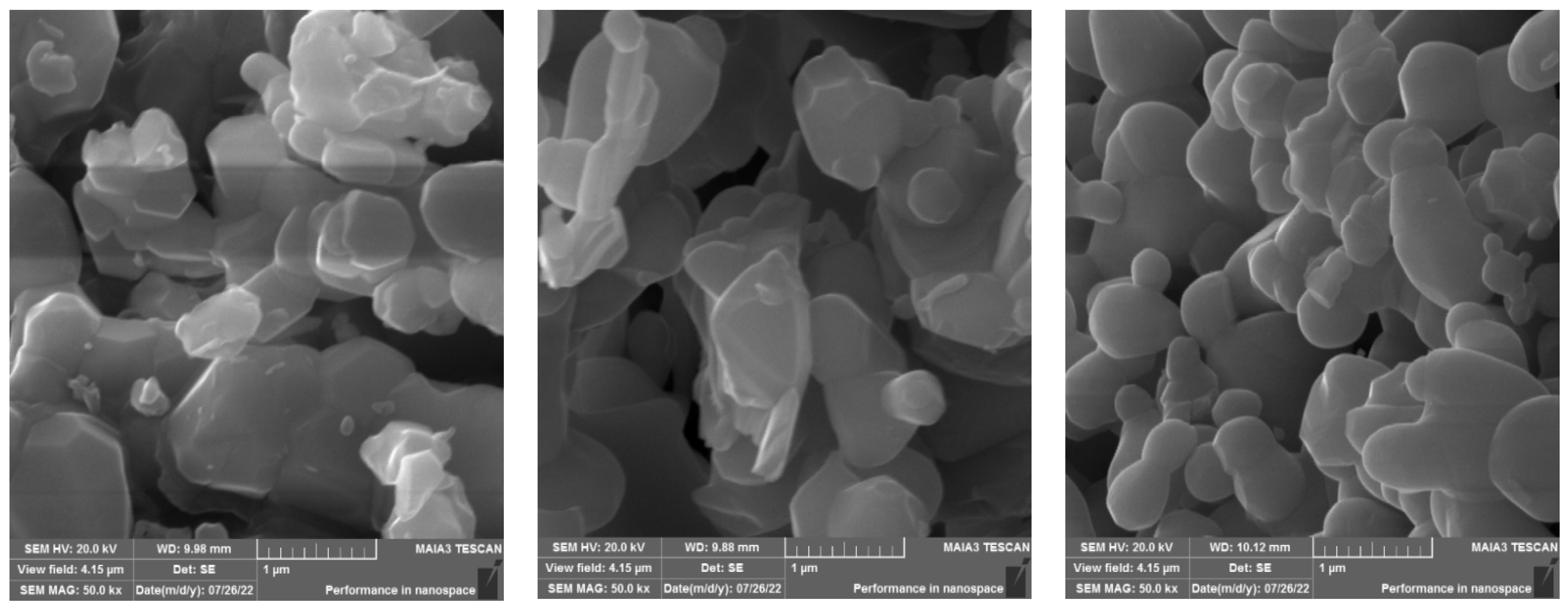Modifying the Optical Properties of ZnS for Optoelectronic Applications †
Abstract
1. Introduction
2. Experimental Details
3. Results and Discussion
4. Conclusions
Author Contributions
Funding
Institutional Review Board Statement
Informed Consent Statement
Data Availability Statement
Conflicts of Interest
References
- Quan, Z.; Wang, Z.; Yang, P.; Lin, J.; Fang, J. Synthesis and characterization of high-quality ZnS, ZnS:Mn2+, and ZnS:Mn2+/ZnS (core/shell) luminescent nanocrystals. Inorg. Chem. 2007, 46, 1354–1360. [Google Scholar] [CrossRef] [PubMed]
- Li, X.; Wang, X.; Xiong, Q.; Eklund, P.C. Mechanical properties of ZnS nanobelts. Nano Lett. 2005, 5, 1982–1986. [Google Scholar] [CrossRef]
- Corrado, C.; Jiang, Y.; Oba, F.; Kozina, M.; Bridges, F.; Zhang, J.Z. Synthesis, structural, and optical properties of stable ZnS:Cu, Cl nanocrystals. J. Phys. Chem. A 2009, 113, 3830–3839. [Google Scholar] [CrossRef]
- Kumar, S.; Verma, N.K. Structural, optical and magnetic investigations on Fe-doped ZnS nanoparticles. J. Mater. Sci. Mater. Electron. 2015, 26, 2754–2759. [Google Scholar] [CrossRef]
- Theivasanthi, T.; Kartheeswari, N.; Alagar, M. Chemical precipitation synthesis of ferric chloride doped zinc sulphide nanoparticles and their characterization studies. arXiv 2013, arXiv:1303.2531. [Google Scholar]
- Lee, G.J.; Wu, J.J. Recent developments in ZnS photocatalysts from synthesis to photocatalytic applications—A review. Powder Technol. 2017, 318, 8–22. [Google Scholar] [CrossRef]
- Kim, H.J.; Kim, J.H.; Durga, I.K.; Punnoose, D.; Kundakarla, N.; Reddy, A.E.; Rao, S.S. Densely packed zinc sulfide nanoparticles on TiO 2 for hindering electron recombination in dye-sensitized solar cells. New J. Chem. 2016, 40, 9176–9186. [Google Scholar] [CrossRef]
- Zafar, S.; Zubair, M.; Shah, S.M.; Khan, M.I.; Khan, A.A.; Iqbal, M.F.; Hassan, A.; Din, M.F.U. Effect of Fe doping on the structural and optical properties of ZnS macro-spheres. Optik 2022, 262, 169–342. [Google Scholar] [CrossRef]
- Mahour, L.N.; Choudhary, H.K.; Kumar, R.; Anupama, A.V.; Sahoo, B. Structural, optical and Mössbauer spectroscopic investigations on the environment of Fe in Fe-doped ZnO (Zn1-xFexO) ceramics synthesized by solution combustion method. Ceram. Int. 2019, 45, 24625–24634. [Google Scholar] [CrossRef]
- Poornaprakash, B.; Reddy, D.A.; Murali, G.; Rao, N.M.; Vijayalakshmi, R.P.; Reddy, B.K. Composition dependent room temperature ferromagnetism and PL intensity of cobalt doped ZnS nanoparticles. J. Alloys Compd. 2013, 577, 79–85. [Google Scholar] [CrossRef]
- Sambasivam, S.; Joseph, D.P.; Reddy, D.R.; Reddy, B.K.; Jayasankar, C.K. Synthesis and characterization of thiophenol passivated Fe-doped ZnS nanoparticles. Mater. Sci. Eng. 2008, 150, 125–129. [Google Scholar] [CrossRef]
- Lee, J.C.; Gopalan, A.I.; Sai-Anand, G.; Lee, K.P.; Kim, W.J. Preparation of visible light photocatalytic graphene embedded rutile titanium (IV) oxide composite nanowires and enhanced NOx removal. Catalysts 2019, 9, 170. [Google Scholar] [CrossRef]
- Panigrahy, B.; Aslam, M.; Misra, D.S.; Bahadur, D. Polymer-mediated shape-selective synthesis of ZnO nanostructures using a single-step aqueous approach. CrystEng Comm. 2009, 11, 1920–1925. [Google Scholar] [CrossRef]
- Karar, N.; Singh, F.; Mehta, B.R. Structure and photoluminescence studies on ZnS:Mn nanoparticles. J. Appl. Phys. 2004, 95, 656–660. [Google Scholar] [CrossRef]
- Ghosh, P.K.; Ahmed, S.F.; Jana, S.; Chattopadhyay, K.K. Photoluminescence and field emission properties of ZnS:Mn nanoparticles synthesized by rf-magnetron sputtering technique. Opt. Mater. 2007, 29, 1584–1590. [Google Scholar] [CrossRef]
- Peng, W.Q.; Cong, G.W.; Qu, S.C.; Wang, Z.G. Synthesis and photoluminescence of ZnS:Cu nanoparticles. Opt. Mater. 2006, 29, 313. [Google Scholar] [CrossRef]
- Zhang, L.; Qin, D.; Yang, G.; Zhang, Q. The investigation on synthesis and optical properties of ZnS:Co nanocrystals by using hydrothermal method. Chalcogenide Lett. 2012, 9, 93–98. [Google Scholar]
- Hassanien, A.S.; Sharma, I. Band-gap engineering, conduction and valence band positions of thermally evaporated amorphous Ge15-x Sbx Se50 Te35 thin films: Influences of Sb upon some optical characterizations and physical parameters. J. Alloys Compd. 2019, 798, 750–763. [Google Scholar] [CrossRef]
- Hassanien, A.S.; Akl, A.A. Optical characteristics of iron oxide thin films prepared by spray pyrolysis technique at different substrate temperatures. Appl. Phys. A 2018, 124, 752. [Google Scholar] [CrossRef]


| x | Crystallite Size (nm) | Dislocation Density ×1015 (m−2) | Microstrain ×10−4 | Bandgap (eV) |
|---|---|---|---|---|
| 0 | 20 | 2.48 | 37.66 | 3.97 |
| 0.2 | 18 | 3.08 | 41.98 | 3.7 |
| 0.4 | 15 | 3.95 | 47.75 | 3.5 |
Disclaimer/Publisher’s Note: The statements, opinions and data contained in all publications are solely those of the individual author(s) and contributor(s) and not of MDPI and/or the editor(s). MDPI and/or the editor(s) disclaim responsibility for any injury to people or property resulting from any ideas, methods, instructions or products referred to in the content. |
© 2023 by the authors. Licensee MDPI, Basel, Switzerland. This article is an open access article distributed under the terms and conditions of the Creative Commons Attribution (CC BY) license (https://creativecommons.org/licenses/by/4.0/).
Share and Cite
Raza, A.; Noor, H.; Riaz, S.; Naseem, S. Modifying the Optical Properties of ZnS for Optoelectronic Applications. Eng. Proc. 2023, 32, 18. https://doi.org/10.3390/engproc2023032018
Raza A, Noor H, Riaz S, Naseem S. Modifying the Optical Properties of ZnS for Optoelectronic Applications. Engineering Proceedings. 2023; 32(1):18. https://doi.org/10.3390/engproc2023032018
Chicago/Turabian StyleRaza, Ali, Hadia Noor, Saira Riaz, and Shahzad Naseem. 2023. "Modifying the Optical Properties of ZnS for Optoelectronic Applications" Engineering Proceedings 32, no. 1: 18. https://doi.org/10.3390/engproc2023032018
APA StyleRaza, A., Noor, H., Riaz, S., & Naseem, S. (2023). Modifying the Optical Properties of ZnS for Optoelectronic Applications. Engineering Proceedings, 32(1), 18. https://doi.org/10.3390/engproc2023032018





